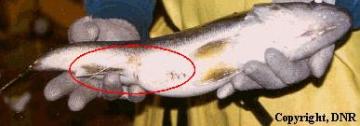Fish with a wire antenna
Fishing Wisconsin
The Department of Natural Resources (DNR) fisheries biologists track fish for research purposes. There are various ways DNR marks fish which are part of these research studies:
- a tag is attached to the fish, or
- a radio transmitter is implanted, as noted by a wire antenna, or
- a code wire tag is implanted, as identified by a missing adipose fin.
DNR discourages anglers from tagging their own fish.
Should you catch a DNR-tagged fish, it is very important to report the requested information promptly. The information provided by the angler helps DNR to determine fish population estimates, and harvest and exploitation rates. Your cooperation and participation are greatly appreciated.
Do not remove the tags when releasing a DNR-tagged fish.
Fish with wire antennas (radio transmitters)
When a wire antenna is found extending out from the body of a fish you have caught, it is likely that the DNR has implanted a radio transmitter in it. These transmitters are used to track the movements and behavioral patterns of the fish. Radio transmitters have been used in the following areas:
- walleye and smallmouth bass in the Lower Milwaukee River Harbor
- walleye, musky and sturgeon in the Turtle Flambeau Flowage and connecting Manitowish River
Requested information and notifying the DNR
Catching a walleye, musky or sturgeon in the Turtle Flambeau Flowage or Manitowish River with a wire antenna extending out from its body, please release the fish safely back to the water and call the DNR office below with the fish species, accurate length, location, time and date of capture.
Wisconsin DNR
2501 Golf Course Road
ASHLAND, WI 54806
(715) 492-5276
If the fish appears dead, please bring the fish to the DNR office above, along with the transmitter.
Fish with radio transmitters are not to be consumed!
- If you catch a fish with a tag, please see our web page on catching a tagged fish.
- If you catch a fish with a missing adipose (back) fin, please see our web page on catching a fish with a missing adipose fin.
- If you are unsure to who to report your information, please contact the Bureau of Fisheries Management.
For more information, please contact: Fisheries Management

